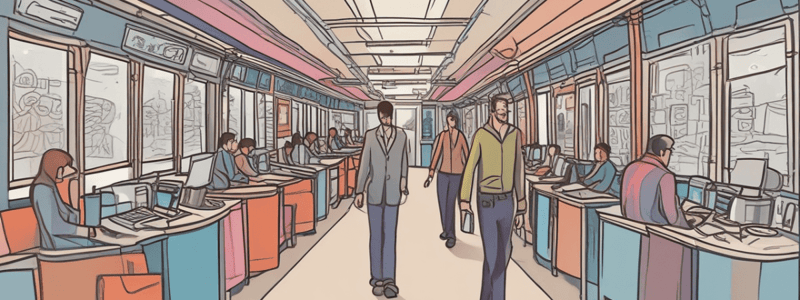Podcast
Questions and Answers
What causes provider gap 1?
What causes provider gap 1?
- Disparity between service delivery and customer satisfaction
- Disparity between company policies and employee performance
- Disparity between product quality and customer feedback
- Disparity between customer expectations and the company's perception of those expectations (correct)
Which factor is NOT attributed to provider gap 1?
Which factor is NOT attributed to provider gap 1?
- Inadequate service recovery
- Insufficient relationship focus
- Inadequate customer research orientation
- Effective communication strategies (correct)
Which dimension is NOT one of the five service quality dimensions?
Which dimension is NOT one of the five service quality dimensions?
- Reliability
- Tangibles
- Emotion (correct)
- Empathy
What is an example of inadequate customer research orientation?
What is an example of inadequate customer research orientation?
Which factor contributes to a customer's overall satisfaction in service encounters?
Which factor contributes to a customer's overall satisfaction in service encounters?
What defines the adaptability factor in service quality?
What defines the adaptability factor in service quality?
What is a key reason for the importance of customer satisfaction in a business?
What is a key reason for the importance of customer satisfaction in a business?
How do emotions influence customer satisfaction?
How do emotions influence customer satisfaction?
Which of the following best describes the concept of perception of equity or fairness in customer satisfaction?
Which of the following best describes the concept of perception of equity or fairness in customer satisfaction?
Which factor does NOT impact customer satisfaction according to the provided content?
Which factor does NOT impact customer satisfaction according to the provided content?
What does ACSI stand for, and what is its purpose?
What does ACSI stand for, and what is its purpose?
Why do service customers generally receive lower satisfaction ratings on ACSI compared to product customers?
Why do service customers generally receive lower satisfaction ratings on ACSI compared to product customers?
Flashcards are hidden until you start studying
Study Notes
Provider Gap 1
- Provider gap 1 arises from the difference between customer expectations and the company's understanding of those expectations.
- Contributing factors include inadequate customer research, lack of upward communication, insufficient relationship focus, and inadequate service recovery.
Factors Contributing to Provider Gap 1
- Inadequate Customer Research Orientation: Research often overlooks service quality, failing to align with customer expectations.
- Lack of Upward Communication: Excessive layers of hierarchy hinder effective communication between contact personnel and top management.
- Insufficient Relationship Focus: Emphasis on individual transactions takes precedence over building enduring customer relationships.
- Inadequate Service Recovery: Companies do not prioritize listening to customer complaints, leading to unresolved issues.
Service Quality Dimensions
- Five dimensions crucial to service quality evaluation:
- Reliability: Consistency in performance and dependability.
- Responsiveness: Willingness to help customers promptly.
- Assurance: Knowledge and courtesy of employees, instilling confidence.
- Empathy: Personalized attention and care for customers.
- Tangibles: Physical facilities, equipment, and appearance of personnel.
Service Encounter Cascade
- Each interaction provides a snapshot of the organization's service quality, influencing overall customer satisfaction.
- Factors Impacting Customer Satisfaction:
- Recovery: How employees handle service failures affects customer perceptions.
- Adaptability: Employees' ability to respond effectively to customer needs contributes positively to their experience.
- Spontaneity: Unsolicited and proactive employee actions can enhance customer satisfaction.
- Coping: Employee strategies for managing difficult customers play a significant role in customer impressions.
Customer Satisfaction
- Defined as consumers' fulfillment response to products and services.
- Indicates a pleasurable level of consumption, critical for retaining customers and enhancing company reputation.
Importance of Customer Satisfaction
- Essential for customer retention, contributing to long-term business success.
- Helps in building a positive reputation for the company.
Determinants of Customer Satisfaction
- Product and Service Features: Quality and attributes of the product or service, e.g., hotel facilities.
- Customers' Emotions: Pre-existing moods influence experiences and perceptions of service.
- Attributions for Service Success or Failure: How customers interpret causes of service outcomes affects their evaluation.
- Perception of Equity or Fairness: Customers gauge their service experience based on perceived fair treatment relative to others.
- Social Influences: Opinions of other customers, family members, and coworkers can shape satisfaction levels.
ACSI (American Customer Satisfaction Index)
- Serves as a key measure of customer satisfaction in the United States.
- Used as an economic indicator; rising satisfaction suggests healthy business performance.
Connection to Business Outcomes
- Higher customer satisfaction correlates with increased customer loyalty and profitability.
- Services often receive lower satisfaction ratings on ACSI due to the unpredictability of factors compared to tangible goods.
Studying That Suits You
Use AI to generate personalized quizzes and flashcards to suit your learning preferences.




